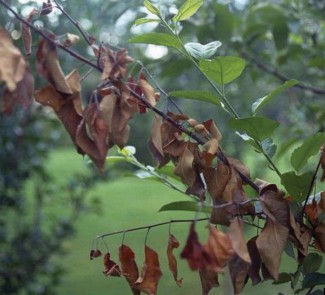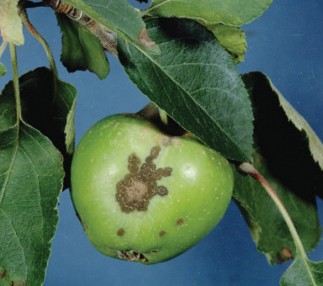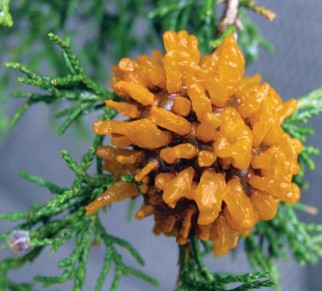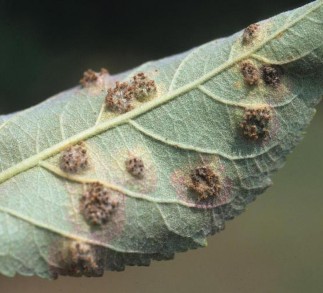
Important Apple Diseases in Montana and Recommended Varieties for Resistance
Apples are a wonderful addition to the landscape, but there are several common diseases which affect apples and crabapples in Montana. The best control is to plant a cold-hardy, resistant variety. A table of some recommended varieties is included in this publication as well as color photos to assist with disease identification.
Last Updated: 01/20by Eva Grimme, Associate Extension Specialist II; Zach Miller, Assistant Professor and Superintendent MSU Western Ag. Research Center; Cheryl Moore-Gough, Extension Horticulture Specialist; Nina Zidack, Plant Pathologist, and Mary Burrows, Extension Plant Pathologist
APPLE AND CRABAPPLE TREES CAN PRODUCE
reliable crops if you pay attention to the varieties you are purchasing. Whenever possible, purchase trees locally from a reputable nursery. If you live in a part of the state that experiences particularly tough winters (e.g. USDA zones 3–4), select cold-hardy varieties grafted to a cold-hardy rootstock (Table 1). Rootstock also determines the size of the mature tree. Smaller trees (i.e. grafted onto dwarf or semi-dwarfing rootstocks) are easier to harvest, prune, and manage pests.
Not all varieties perform well in all parts of the state. For example, in USDA Zone 3 or 4, select summer or early fall-ripening varieties, appropriate to a shorter growing season. Most of these will ripen in less than 120 days following bloom. If you’re lucky enough to live in Zone 5, add the later ripening apples, like the mid-season ‘McIntosh’ that takes up to 140 days to ripen. Select disease-resistant varieties whenever possible.
Winter hardiness and ripening period are listed in this guide to assist in purchasing plants appropriate to your area. Remember that apples and crabapples depend on cross- pollination, therefore, plant two different varieties with similar bloom periods to ensure adequate fruit set.
Common Apple Diseases
In Montana, there are four diseases that home gardeners, nursery, and orchard growers commonly see on apples. The most serious disease is fire blight. In highly susceptible varieties, this disease can cause a steady decline and ultimately, death of the tree. Apple scab can occur in wet springs and be very damaging to foliage and fruit, but generally does not threaten the overall health of the tree. Cedar-apple rust is a pathogen that affects both apples and junipers. On apples, it causes a leaf spot and can also cause lesions on fruit, reducing fruit quality. Powdery mildew is a very common disease that affects leaves, shoots and fruit.
Fire Blight
Fire blight is the most problematic and prevalent disease of apple in Montana and is found throughout the state. The disease is caused by the plant pathogenic bacterium Erwinia amylovara, and is also a serious problem in pear, cotoneaster and mountain ash. It is especially damaging during years with sustained rainfall and high humidity throughout the flowering period.

Figure 1: Fire blight-affected twig. BY WILLIAM JACOBI, COLORADO STATE UNIVERSITY, BUGWOOD.ORG 5367249
Disease Life Cycle and Symptoms
The bacteria that cause fire blight overwinter in cankers and become active when the temperature reaches 65 F. Cankers are identified as areas of sunken and darker bark and will produce an orange ooze. Bacteria are spread from plant to plant by rain splash from nearby infected trees, by insects pollinating flowers, and by contaminated pruning tools. The optimal temperatures for flower infection and growth of the bacteria are 65–85 F. Upon flower infection, the bacteria multiply and begin to travel down the soft tissue into the older tissue of the twigs. During times of prolonged rainfall and high humidity, bacteria can also directly infect young, actively-growing twigs, entering the plant tissue through wounds or natural openings such as stomata and lenticels.
Fire blight infections result in a rapid dieback of the shoot tips which give the leaves a burned appearance, hence the name “fire blight” (Figure 1). Infected twigs develop sunken, brown-black cankers (Figure 2). Peeling back the bark in infected parts of the plant will reveal a streaky brown stain. In larger branches, the cankers in the bark are often charcoal black and exhibit excessive peeling. If left unchecked, this disease will cause a steady decline and will ultimately kill infected trees.

Figure 2: The dark and sunken bark indicates a fire blight canker on a young branch. BY WILLIAM JACOBI, COLORADO STATE UNIVERSITY, BUGWOOD.ORG 5367254
Management
Cultural Control. Fire blight is most damaging in young, rapidly growing trees. The primary method for removing fire blight from an affected tree is pruning. Fire blight-infested twigs and branches can be pruned out when symptoms are observed, as long as branches are dry, and humidity is low. Prune back 12–14 inches below infected area, since bacteria move beyond symptomatic areas (Smith and DuPont 2017). Continue to prune out infected tissue while the tree is dormant, after leaf drop or early in the spring before leaves emerge. Removing infected twigs and branches will reduce the likelihood of the bacteria moving to other parts of the tree. It will also reduce the amount of inoculum in the spring which might provide a source for new infections.
To determine if you had fire blight last year, evaluate the tree for the presence of twigs and branches that did not lose their leaves (Figure 1), or have mummified fruit still attached. Make the pruning cut at least 12–14 inches below the symptomatic twigs or cankers. After pruning out the twig or branch, peel back the bark at the point where the cut was made and look to see if there is any reddish-brown streaking or flecking, which is a sign of infection. If there is, prune back from that point and check again for signs of infection. Take care to prune when the plants are dry and disinfect the pruning tools with a 10 percent bleach solution or rubbing alcohol between cuts. After bud-break and leafing out, monitor pruning cuts for advancing infections. If new cankers begin to form around old pruning sites, make new cuts 12–14 inches below the previous cuts. Also, scout plants for new infections which may show up on new growth.
Susceptibility to fire blight can also be reduced by limiting nitrogen fertilizer. High nitrogen applications lead to excessive succulent growth, which is highly susceptible to fire blight. Watersprouts at the base of the tree are also highly susceptible and provide a direct avenue for infections of the trunk, which can be lethal to the tree. Prune out all watersprouts during warm and dry weather, or in the fall when the tree is dormant.
Variety Resistance. To prevent fire blight from occurring, or to reduce the negative impacts on the landscape, resistant varieties of eating apples are listed in Table 2. A resistant variety exhibits less disease damage compared to other varieties under similar growing condition and disease pressure.
Chemical Control. The only effective chemical controls available for fire blight reduce the risk of infection by killing the bacteria. There are no chemical cures once symptoms form. Antibiotics such as streptomycin and copper formulations can prevent bloom infection only and must be properly timed and applied (MSU-WARC apple guide).
Apple Scab
Apple scab, a commonly occurring foliar and fruit disease of apple, is caused by the fungus Venturia inaequalis. Unlike the cedar-apple rust pathogen following, this fungus completes its entire life cycle on just one host.
Scab has caused sporadic but serious losses in certain Montana areas. Scab is normally most serious in areas with frequent rain and high relative humidity. In the protected, wetter intermountain valleys, the commonly grown McIntosh variety has been severely damaged. Less serious infections have been observed in other varieties and in drier areas of Montana. Infected trees will experience reduced vigor and subsequent lower yields as well as reduced fruit quality. Excessive foliage loss often occurs in mid-summer, predisposing affected trees to winter injury and other secondary problems.
Newer varieties of crab apples generally have good levels of scab resistance (Table 2). However, individual trees will occasionally experience scab infections in some areas, especially on trees where the previous year’s leaf litter is not removed.

Figure 3: Apple scab lesions on apple leaves. JOSEPH OBRIEN, USDA FOREST SERVICE, BUGWOOD.ORG UGA5047080
Disease Life Cycle and Symptoms
The fungus survives the winter on fallen leaves remaining on the soil surface. As warm weather arrives, the fungus becomes active and begins to produce spores on plant residue. These spores are continually discharged and blown onto newly emerging leaves. In the presence of moisture, the spores germinate and create a new lesion in seven to 14 days. As the temperature rises and the weather dries, the fungus becomes less active. Fall infections may occur but are of little or no importance in Montana.
Initially, infections are characterized by small, olive green spots with a feathery margin. As the lesions age, they darken and increase in size. In many instances, the lesions are more numerous along the leaf midrib and veins since water congregates in these areas (Figure 3). Leaf stems may also be infected, which hastens leaf loss.
Fruit infections commonly occur. On infected apples, the fruit appears scabby, cracked and often misshapen (Figure 4). Damage is normally superficial and although unsightly, the fruit is edible.

Figure 4: Apple scab lesions on apple fruit. BY CLEMSON UNIVERSITY, USDA COOPERATIVE EXTENSION SLIDE SERIES, BUGWOOD.ORG UGA1234176
Management
Cultural Control. In homeowner situations where few trees are involved, scab can effectively be reduced by raking and destroying infected leaves in the fall. This reduces the potential for the pathogen to overwinter. Pruning trees to open the canopy will also reduce the duration of leaf wetting and infection. Avoid sprinkler irrigation which wets the foliage.
Variety Resistance. When establishing new plantings, the selection of scab resistant varieties offers the easiest method of control (Table 2). A resistant variety exhibits less disease damage compared to other varieties under similar growing condition and disease pressure.
Chemical Control. Captan and Immunox fungicides are available to homeowners. Lime sulfur and wettable sulfur products provide organic alternatives. Sulfur products can cause injury to the foliage and fruits and are not as effective as chemical fungicides.
Cedar-Apple Rust
Cedar-apple rust of apple and crabapple is caused by the fungus Gymnosporangium juniperi-virginianae. Several species of the genus Juniperus – including Eastern red cedar, Rocky Mountain juniper, and horizontal juniper – are alternate hosts for this disease. The rust fungus requires both, a Juniperus species and an apple or crabapple to complete its lifecycle.
In Montana, sporadic outbreaks will occur on susceptible apple and crabapple varieties. Damage will vary with the year, but the most severe injury normally occurs when wet, mild weather occurs in mid-May or June. Closely related fungi with similar lifecycles are often observed on hawthorn and serviceberry. The hawthorn pathogen can cause dramatic yellowing and subsequent leaf loss in most years. The symptoms, similar to those observed on apple and crabapples, begin appearing in mid-July and increase in severity during the remainder of the growing season. Severely infected trees are more prone to invasion by other diseases and insects. In wild stands of serviceberry, the utility of the fruit is often impaired by this related pathogen. Direct fruit infection, with associated tentacle development, is commonly observed during the harvest season.

Figure 5: Gelatinous galls formed on juniper. JOSEPH OBRIEN, USDA FOREST SERVICE, BUGWOOD.ORG UGA1377009
Disease Life Cycle and Symptoms
The fungus overwinters in brownish globular galls—“cedar apples”—which begin to form on the juniper in late summer. The following spring, the galls grow rapidly and produce orange gelatinous “horns” during moist weather (Figure 5). These horns release spores shortly after they absorb moisture. Spores can be produced over an extended period of repeated wetting and drying. They are forced into the air and can be carried long distances by wind.
Spores that land on an apple leaf will germinate and infect the leaf if conditions are warm and moist. Orange pustules surrounded by a yellow halo form on the upper surfaces of the leaves shortly after bloom (Figure 6). Fruit may also become infected. One to two months later, orange finger-like, cylindrical tubes will develop on the underside of the leaf or on the fruit (Figure 7). Under dry conditions, these structures will release spores to complete the disease cycle on a juniper.

Figure 6: Cedar-apple rust lesions on apple leaves. JAMES CHATFIELD, OHIO STATE UNIVERSITY, BUGWOOD.ORG 5486242

Figure 7: Cedar-apple rust lesions on the underside of apple leaves. GERALD HOLMES, CALIFORNIA POLYTECHNIC STATE UNIVERSITY AT SAN LUIS OBISPO, BUGWOOD.ORG 1577114
Management
Cultural control. Since the fungus requires both hosts to complete its life cycle, removal of nearby apple or juniper plants may break the disease cycle. However, spores can be carried by wind for up to two miles, and if both hosts are valued plants, other means of control are necessary. Removal and burning of cedar-apple rust galls before the horns form will help control the disease.
Variety Resistance. The best method of control, as with all diseases, is to plant resistant varieties of apple or juniper. A resistant variety exhibits less disease damage compared to other varieties under similar growing condition and disease pressure.
Apple varieties resistant to cedar-apple rust are found in Table 2.
Among the alternate hosts, Pfitzer juniper (Juniperus media pfitzeriana), Goldtip Pfitzer juniper (J. pfitzeriana aurea), Sargent juniper (J. media sargentii), Savin juniper (J. sabina), and its varieties Von Ehron, Skandia, and Arcadia, Common juniper (J. communis) and Meyer juniper (J. squamata ‘Meyeri’) are resistant to this rust.
Chemical control. If chemical control is considered necessary, it is most effective when applied to the apple or related species. In commercial operations, where rust is a recurring problem, fungicides labeled for rust control should be used during the appropriate spray schedule window. The sprays should provide protection during the period in which the spores are being released from the gelatinous galls.
Powdery Mildew
Powdery mildew of apple and crab apple is caused by the fungal pathogen Podosphaera leucotricha. It is commonly found on apple throughout Montana, but is usually not damaging. If weather conditions in spring are mild, bud infections can result in some death of terminals which can weaken the tree. Severity depends on the temperature and humidity in the environment. Powdery mildew is an important disease worldwide and also occurs on pear and quince.
Disease Life Cycle and Symptoms
The powdery mildew fungus causes disease on apple buds, flowers, leaves and fruit. The fungus overwinters in the terminal buds and in the spring, spores germinate and invade the newly emerging leaves and flowers. Infected blossoms turn brown and shrivel. Emerging leaves are often completely covered with a white mat and appear distorted and curled (Figure 8). When conditions are moist, multiple cycles of infection occur. Infections of expanded leaves have round, cottony patches on the surface. Over time, infected leaves become brown and brittle, and are prematurely shed from the tree. Infected fruit has a network of lines which is often referred to as russeting (Figure 9).
Management
Cultural Control. Consider healthy pruning of the tree to promote good air circulation. Dormant pruning of infected twigs will reduce inoculum for the next growing season but is marginally effective. It is often not practical to prune due to lack of symptoms to target pruning.
Variety Resistance. There are relatively few varieties with resistance to powdery mildew (Table 2). A resistant variety exhibits less disease damage compared to other varieties under similar growing condition and disease pressure.

Figure 8: Powdery mildew-affected apple foliage and buds. BY WILLIAM M. BROWN JR., BUGWOOD.ORG 5356832

Figure 9: Russeting symptom on powdery mildew-affected fruit. BY CLEMSON UNIVERSITY, USDA COOPERATIVE EXTENSION SLIDE SERIES, BUGWOOD.ORG UGA1236033
Chemical Control. Control should begin at tight cluster stage, when buds start to open and new inoculum is released. Bicarbonate products including Kaligreen and MilStop provide organic alternatives to chemical fungicides. Wettable sulfur can also provide control, but sulfur can result in leaf burn. Immunox fungicide is effective and is labeled for home use.
REFERENCES
Childers, N.E., J.R. Morris and G.S. Sibbett. 1995. Modern Fruit Science. Horticultural publications.
Gough. R.E.(ed). Montana Master Gardener Handbook, Third Edition. 2004. Montana Extension Publication #SR100 Revised.
Gough, R.E. and C. Moore-Gough. 2007. The Montana Gardener’s Companion. Globe Pequot.
Jones, A.L. and Aldwinckle, H.S. 1990. Compendium of Apple and Pear Diseases. APS Press, St. Paul, Minnesota.
http://www.intermountainfruit.org/IntermountainTFG-2018.pdf. Intermountain Commercial Tree Fruit Production Guide 2018.
https://www.mortonarb.org. The Morton Arboretum.
http://plant-disease.ippc.orst.edu/index.cfm. 2008. An Online Guide to Plant Disease Control. Oregon State University, Corvallis, Oregon.
Brooks and Olmo. 1997. Register of Fruit & Nut Varieties. Third edition. ASHS Press.
MSU-WARC MT apple guide: http://agresearch.montana.edu/warc/guides/index.html
MSU-WARC MT apple guide, fire blight: http://agresearch.montana.edu/warc/guides/fire_blight_in_montana_apple_orchards.html
NC140 rootstock summary: http://www.nc140.org/2004/domotorootstock.pdf
Smith and DuPont 2017: WSU fire blight management: http://treefruit.wsu.edu/article/dealing-with-fire-blight-once-it-is-in-the-orchard/
MacKenzie et al. 2011. Pest management for the home orchard. University of Minnesota Extension: https://conservancy.umn.edu/bitstream/handle/11299/198130/Apple%20Home%20IPM.pdf?sequence=1&isAllowed=y
Apple varieties for Alaska. AK pioneer fruit growers association provides list of cold hardy apple varieties http://www.apfga.org/fruit_varieties/
https://www.ag.ndsu.edu/hort/info/fruit/fruittreevar.htm
https://cashmannursery.com/wp-content/uploads/2018/03/Growing-Fruit-Trees-2018.pdf
| Table 1: Cold-hardy roots stocks with estimated size of mature trees. | |
| Mature Tree Size (Height) | Root Stocks |
Dwarf-Semi Dwarf (8-15 ft.) |
Budagovsky (Bud) 118, 9EMLA (M) 106, 26, 7Geneva 41, 214, 935 |
Standard (20-30 ft.) |
Crabapple: Siberian (M. baccata), Columbia, Dolgo, Ranetka, Ranetka, Red Splendor |
Table 2: Apple varieties recommended for Montana according to hardiness, fruit ripening, and resistance to the diseases fire blight, apple scab, cedar-apple rust, and powdery mildew
| Apple Variety | Winter Hardiness | Ripening Period | Fire Blight | Apple Scab | Cedar-Apple Rust | Powdery Mildew |
| Carroll | Extremely | Early | Resistant | Susceptible | Resistant | |
| Chestnut Crabapple | Very | Early | Resistant | Moderately Resistant | Resistant | Resistant |
| Frostbite | Extremely | Mid Season | Moderately Resistant | Moderately Resistant | ||
| Goodland | Extremely | Early | Moderate | |||
| Haralred | Extremely | Mid Season | Moderately Resistant | Susceptible | ||
| Haralson | Extremely | Late | Resistant | Moderately Resistant | Moderately Resistant | Moderately Resistant |
| Hazen | Very | Early | Moderately Resistant | |||
| Honeycrisp | Very | Mid Season | Resistant | Moderately Resistant | Susceptible | Susceptible |
| Honeygold | Very | Late | Very Susceptible | Resistant | Susceptible | Resistant |
| Kerr Crabapple | Extremely | Mid Season | Moderately Resistant | |||
| Lodi | Very | Early | Susceptible | Susceptible | Susceptible | Resistant |
| McIntosh | Marginal | Mid Season | Moderately Resistant | Resistant | Resistant | Susceptible |
| Norkent | Extremely | Mid Season | Moderately Resistant | |||
| Norland | Extremely | Mid Season | Moderately Resistant | Resistant | ||
| Northern Lights | Very | Mid Season | Resistant | |||
| Parkland | Extremely | Early | Susceptible | Susceptible | ||
| Patterson | Extremely | Mid Season | Resistant | Moderately Resistant | ||
| Red Baron | Marginal | Mid Season | Moderately Resistant | |||
| Red Duchess | Very | Early | Moderately Resistant | Moderately Resistant | Moderately Resistant | |
| Rescue Crabapple | Extremely | Early | Susceptible | Resistant | ||
| State Fair | Very | Early | Very Susceptible | Susceptible | ||
| Sweet Sixteen | Very | Mid Season | Resistant | Susceptible | Resistant | Moderately Resistant |
| Vista Bella | Very | Early | Susceptible | Susceptible | ||
| Wealthy | Very | Mid Season | Susceptible | Susceptible | Susceptible | Susceptible |
| Whitney Crabapple | Very | Mid Season | Moderately Resistant | Resistant | Moderately Resistant | Resistant |
| Yellow Transparent | Very | Early | Very Susceptible | Moderately Resistant | Moderately Resistant | Moderately Resistant |
| Zestar! | Very | Early | Susceptible | Susceptible | Susceptible | Resistant |
Early: August to early September, Mid: September to early October, Late: mid October

